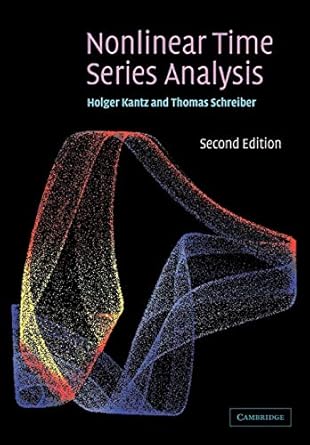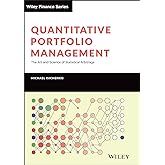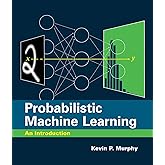
Download the free Kindle app and start reading Kindle books instantly on your smartphone, tablet, or computer - no Kindle device required.
Read instantly on your browser with Kindle for Web.
Using your mobile phone camera - scan the code below and download the Kindle app.

Nonlinear Time Series Analysis 2nd Edition
- ISBN-100521529026
- ISBN-13978-0521529020
- Edition2nd
- PublisherCambridge University Press
- Publication dateJanuary 26, 2004
- LanguageEnglish
- Dimensions6.5 x 0.75 x 9.5 inches
- Print length388 pages
Customers who bought this item also bought
Editorial Reviews
Review
"The book is a good reference to the current state of the art from the nonlinear dynamics community and is importnant reading for anyone faced with interpreting irregular time series." Contemporary Physics, Professor R.S. MacKay
Book Description
Product details
- Publisher : Cambridge University Press; 2nd edition (January 26, 2004)
- Language : English
- Paperback : 388 pages
- ISBN-10 : 0521529026
- ISBN-13 : 978-0521529020
- Item Weight : 1.46 pounds
- Dimensions : 6.5 x 0.75 x 9.5 inches
- Best Sellers Rank: #2,710,020 in Books (See Top 100 in Books)
- #291 in Fluid Dynamics (Books)
- #620 in Mechanics
- #1,886 in Statistics (Books)
- Customer Reviews:
About the author

Discover more of the author’s books, see similar authors, read author blogs and more
Customer reviews
- 5 star4 star3 star2 star1 star5 star60%0%40%0%0%60%
- 5 star4 star3 star2 star1 star4 star60%0%40%0%0%0%
- 5 star4 star3 star2 star1 star3 star60%0%40%0%0%40%
- 5 star4 star3 star2 star1 star2 star60%0%40%0%0%0%
- 5 star4 star3 star2 star1 star1 star60%0%40%0%0%0%
Customer Reviews, including Product Star Ratings help customers to learn more about the product and decide whether it is the right product for them.
To calculate the overall star rating and percentage breakdown by star, we don’t use a simple average. Instead, our system considers things like how recent a review is and if the reviewer bought the item on Amazon. It also analyzed reviews to verify trustworthiness.
Learn more how customers reviews work on Amazon-
Top reviews
Top reviews from the United States
There was a problem filtering reviews right now. Please try again later.
What this book is, is a review/collection of revised manuscripts of some fine articles published by the authors and others who were looking to quantify the experimentally-observed dynamics of chaotic systems. The first edition (1999) of this book is more of a collection of notes, but the second edition is far more comprehensive and well-structured.
The target audience for this book are advanced graduate students who are acquainted with the theory governing nonlinear dynamical systems, undergrad-level stats and advanced linear algebra (topics in topology?). (This 'target audience' description is not didactic as I myself did (do) not know much about either topology or stats before working with this book.)
As the analysis of any experiment is truly just an exercise in statistics, this book expects a broad familiarity with statistical methods. This book is not a general collection of tools that can be applied to every signal out there. So it is expected that the reader already possesses a highly nonlinear/weakly stationary signal that they are interested in deciphering. The authors also provide an online repository of some data sets and routines used as examples in the book (TISEAN package?).
This book steps the reader through specific flavors of embedding, false neighbors counting, linear and nonlinear forecasting techniques through the chapters. In spite of that, most chapters can be used as stand-alone monographs with few continuity issues.
I find the references at the end of each chapter to be sufficient.
Over all, I find this book extremely useful and I have both the two editions in my library. Like most books however a negative feature of this book is that it takes its time in getting to the point (which sometimes gets spread between chapters). I found reading the original articles, cited in a section, before reading that section in the book itself to be particularly helpful.
Kantz and Schreiber do not suffer from that all too common problem. They write clearly and in a very readable style. Their use of real-world datasets and numerous (though not overwhelming) charts makes their work quickly accessible even to beginniners in the field. They provide enough mathematical formalisms to make use of what they present, but not so many as to require a PhD in math to follow the flow of the text. For more advanced readers, they cover a wide range of topics useful both for analysis and for forecasting. Chapter 12, in particular, opened me to a whole world of new techniques.
As my one negative comment on this book, I would have liked that same chapter 12 fleshed out more, to the point that I would buy a follow-up book covering nothing but an elaboration on that single chapter.
If you have an interest in time series analysis and forecasting, and have grown tired of dry material that provides nothing more than yet another extension to ARIMA or Kalman filtering, you will love this book.






